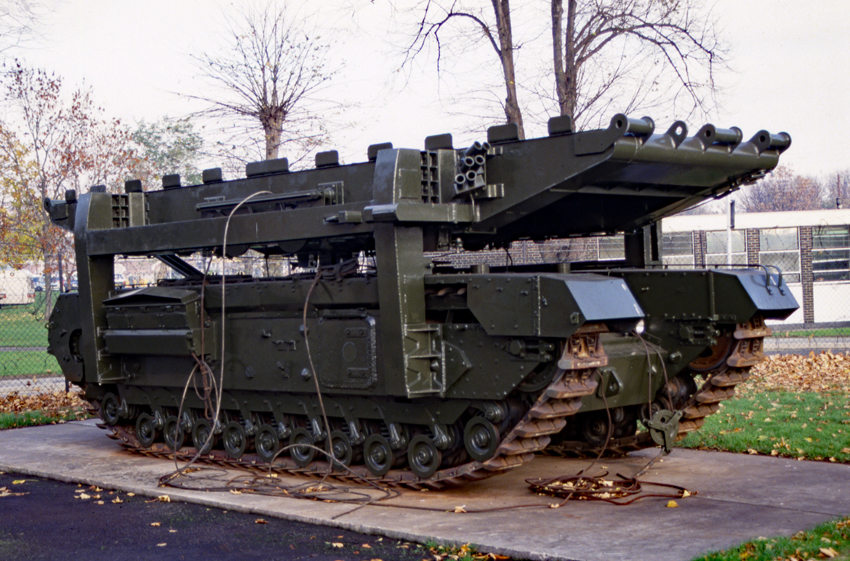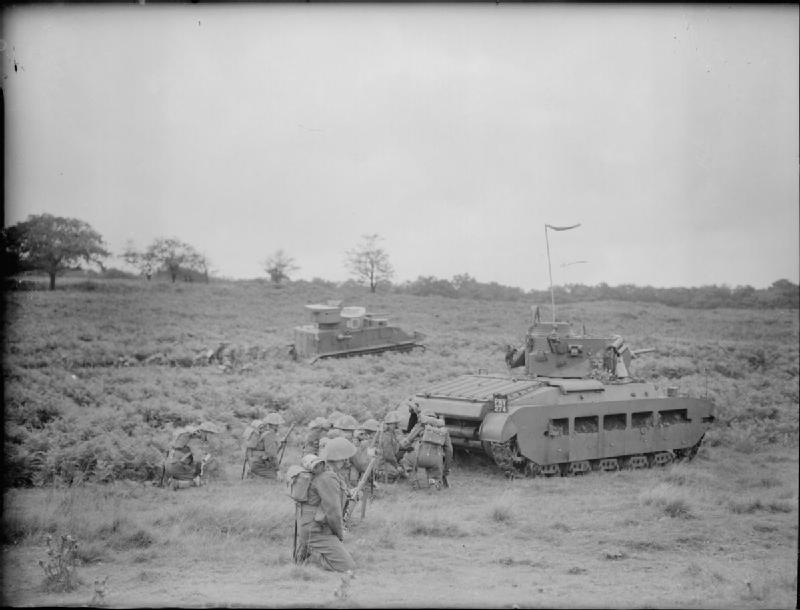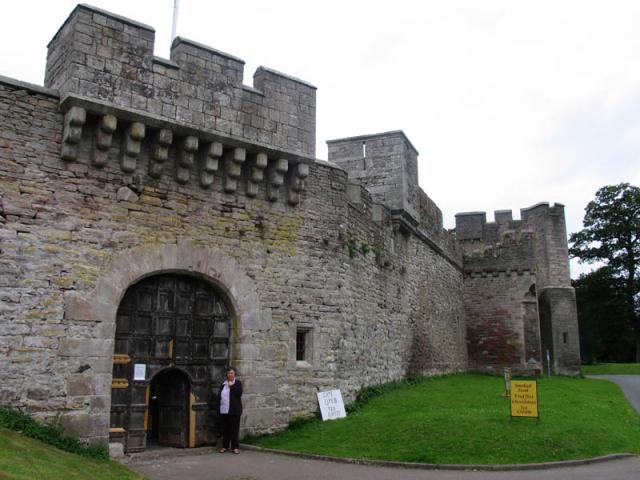|
11th Royal Tank Regiment
The 11th Royal Tank Regiment (11 RTR) was an armoured regiment of the British Army. It is part of the Royal Tank Regiment, itself part of the Royal Armoured Corps. History The 11th Royal Tank Regiment was raised during World War II in January 1941 and designated for the Canal Defence Light (CDL) role in May 1941. The unit trained at Lowther Castle near Penrith, and was based at Brougham Hall, Cumberland. It spent 1942 and 1943 in the Middle East without seeing action, returning to the UK in April 1944. 11 RTR formed part of 79th Armoured Division (aka Hobart's Funnies), equipped initially with CDL (tactical searchlight) tanks. It landed in Normandy on 12 August 1944, seeing no action until 29 September 1944, when it was ordered to transfer all of its equipment to the 42nd and 49th Royal Tank Regiments, and was retrained to operate the American amphibious LVT-4, known by the British Army as the Buffalo Mark IV. Not long after D-Day (6 June 1944) 11 RTR converted to Buffalo (U.S. LV ... [...More Info...] [...Related Items...] OR: [Wikipedia] [Google] [Baidu] |
Armoured Warfare
Armoured warfare or armored warfare (mechanized forces, armoured forces or armored forces) (American English; American and British English spelling differences#-our, -or, see spelling differences), is the use of armoured fighting vehicle, armored fighting vehicles in modern warfare. It is a major component of modern Military science, methods of war. The premise of armoured warfare rests on the ability of troops to penetrate conventional Defense (military), defensive lines through use of Maneuver warfare, manoeuvre by armoured units. Much of the application of armoured warfare depends on the use of tanks and related vehicles used by other supporting arms such as infantry fighting vehicles, self-propelled artillery, and other combat vehicles, as well as mounted combat engineers and other support units. The doctrine of armoured warfare was developed to break the static nature of World War I trench warfare on the Western Front (World War I), Western Front, and return to the 19th ce ... [...More Info...] [...Related Items...] OR: [Wikipedia] [Google] [Baidu] |
Hobart's Funnies
Hobart's Funnies is the nickname given to a number of specialist armoured fighting vehicles derived from tanks operated during the Second World War by units of the 79th Armoured Division of the British Army or by specialists from the Royal Engineers. They were designed in light of problems that more standard tanks experienced during the amphibious Dieppe Raid, so that the new models would be able to overcome the problems of the planned invasion of Normandy. These tanks played a major part on the Commonwealth beaches during the landings. They were forerunners of the modern combat engineering vehicle and took their nickname from the 79th Division's commander, Major General Percy Hobart. The vehicles converted were chiefly Churchill tanks, and American-supplied M4 Sherman tanks. History Plans to invade continental Europe were completely revised after the failure of the raid on Dieppe in 1942. Allied units in Normandy would need to overcome terrain, obstacles and coastal fortific ... [...More Info...] [...Related Items...] OR: [Wikipedia] [Google] [Baidu] |
Prime Minister Of The United Kingdom
The prime minister of the United Kingdom is the head of government of the United Kingdom. The prime minister advises the sovereign on the exercise of much of the royal prerogative, chairs the Cabinet and selects its ministers. As modern prime ministers hold office by virtue of their ability to command the confidence of the House of Commons, they sit as members of Parliament. The office of prime minister is not established by any statute or constitutional document, but exists only by long-established convention, whereby the reigning monarch appoints as prime minister the person most likely to command the confidence of the House of Commons; this individual is typically the leader of the political party or coalition of parties that holds the largest number of seats in that chamber. The prime minister is '' ex officio'' also First Lord of the Treasury, Minister for the Civil Service and the minister responsible for national security. Indeed, certain privileges, such as List ... [...More Info...] [...Related Items...] OR: [Wikipedia] [Google] [Baidu] |
Rhine
), Surselva, Graubünden, Switzerland , source1_coordinates= , source1_elevation = , source2 = Rein Posteriur/Hinterrhein , source2_location = Paradies Glacier, Graubünden, Switzerland , source2_coordinates= , source2_elevation = , source_confluence = Reichenau , source_confluence_location = Tamins, Graubünden, Switzerland , source_confluence_coordinates= , source_confluence_elevation = , mouth = North Sea , mouth_location = Netherlands , mouth_coordinates = , mouth_elevation = , progression = , river_system = , basin_size = , tributaries_left = , tributaries_right = , custom_label = , custom_data = , extra = The Rhine ; french: Rhin ; nl, Rijn ; wa, Rén ; li, Rien; rm, label= Sursilvan, Rein, rm, label= Sutsilvan and Surmiran, Ragn, rm, label=Rumantsch Grischun, Vallader and Puter, Rain; it, Reno ; gsw, Rhi(n), inclu ... [...More Info...] [...Related Items...] OR: [Wikipedia] [Google] [Baidu] |
Operation Plunder
Operation Plunder was a military operation to cross the Rhine on the night of 23 March 1945, launched by the 21st Army Group under Field Marshal Bernard Montgomery. The crossing of the river was at Rees, Wesel, and south of the river Lippe by the British Second Army under Lieutenant General Miles Dempsey, and the United States Ninth Army under Lieutenant General William H. Simpson. The First Allied Airborne Army conducted Operation Varsity on the east bank of the Rhine in support of Operation Plunder, consisting of U.S. XVIII Airborne Corps, the British 6th and the U.S. 17th Airborne Divisions. Preparations such as accumulation of supplies, road construction, and the transport of 36 Royal Navy landing craft, were hidden by a massive smoke screen from 16 March. The operation commenced on the night of 23 March 1945. It included the ''Varsity'' parachute and glider landings near Wesel, and Operation Archway, by the Special Air Service. Battle Four thousand Allied guns ... [...More Info...] [...Related Items...] OR: [Wikipedia] [Google] [Baidu] |
Normandy Landings
The Normandy landings were the landing operations and associated airborne operations on Tuesday, 6 June 1944 of the Allied invasion of Normandy in Operation Overlord during World War II. Codenamed Operation Neptune and often referred to as D-Day, it was the largest seaborne invasion in history. The operation began the liberation of France (and later western Europe) and laid the foundations of the Allied victory on the Western Front. Planning for the operation began in 1943. In the months leading up to the invasion, the Allies conducted a substantial military deception, codenamed Operation Bodyguard, to mislead the Germans as to the date and location of the main Allied landings. The weather on D-Day was far from ideal, and the operation had to be delayed 24 hours; a further postponement would have meant a delay of at least two weeks, as the invasion planners had requirements for the phase of the moon, the tides, and the time of day that meant only a few days each month were ... [...More Info...] [...Related Items...] OR: [Wikipedia] [Google] [Baidu] |
Landing Vehicle Tracked
The Amphibious Vehicle, Tracked (LVT) is an amphibious warfare vehicle and amphibious landing craft, introduced by the United States Navy and United States Marine Corps. (The USN and USMC use "L" to designate Amphibious vessels, also called "L class.") The United States Army, Canadian Army and British Army used several LVT models during World War II, and referred to those vehicles as "Landing Vehicle, Tracked." Originally intended solely as cargo carriers for ship to shore operations, they evolved into assault troop and fire support vehicles. The types were known as amphtrack, "amtrak", "amtrac", etc. (portmanteaus of "amphibious tractor"), and "alligator" or "gator." Development The Alligator The LVT had its origins in a civilian rescue vehicle called the ''Alligator''. Developed by Donald Roebling in 1935, the Alligator was intended to operate in swampy areas, inaccessible to both traditional cars and boats. Two years later, Roebling built a redesigned vehicle wit ... [...More Info...] [...Related Items...] OR: [Wikipedia] [Google] [Baidu] |
49th Royal Tank Regiment
49th Royal Tank Regiment (49 RTR), later 49th Armoured Personnel Carrier Regiment and 49th Armoured Carrier Regiment, was a regiment of the British Army's Royal Armoured Corps during World War II that operated specialised armoured fighting vehicles in North West Europe. Origin and training As part of the rearmament of the British Army before World War II, the 6th Battalion Royal Northumberland Fusiliers, a Territorial Army infantry battalion, was converted to the armoured role on 1 November 1938, under the designation 43rd (6th City) Battalion, The Royal Northumberland Fusiliers, Royal Tank Regiment, or '43 RTR' for short. During 1939, it formed 49 RTR as a duplicate regiment. The regiments shared St George's Drill Hall in Newcastle upon Tyne as their depot. While 43 RTR used the conventional 'A', 'B' and 'C' squadron designations, 49 RTR adopted 'X', 'Y' and 'Z' for its squadrons.Scull. Both regiments were part of 25th Army Tank Brigade. In August 1939, 49 RTR had still not re ... [...More Info...] [...Related Items...] OR: [Wikipedia] [Google] [Baidu] |
42nd Royal Tank Regiment
The 42nd Royal Tank Regiment (42 RTR) was an armoured regiment of the British Army from 1938 until 1956. It was part of the Royal Tank Regiment, itself part of the Royal Armoured Corps. Mobilisation The unit was formed on 1 November 1938 by converting the 7th (23rd London) Battalion, East Surrey Regiment, a Territorial Army (TA) infantry battalion, into a tank unit. For a short while it was 42nd (7th (23rd London) Battalion, East Surrey Regiment) Battalion of the Royal Tank Corps before the corps was redesignated the Royal Tank Regiment in 1939. World War II The regiment was mobilised on the outbreak of war on 3 September 1939 as part of 21st Army Tank Brigade, composed of three TA battalions of the Royal Tank Regiment. The unit formed part of 1st Army Tank Brigade in 1941–42, serving with it in the Western Desert Campaign including the Second Battle of El Alamein. For the invasion of Northern Europe in 1944, it was equipped with Canal Defence Light Grant tanks. The ... [...More Info...] [...Related Items...] OR: [Wikipedia] [Google] [Baidu] |
79th Armoured Division (United Kingdom)
The 79th Armoured Division was a specialist armoured division of the British Army created during the Second World War. The division was created as part of the preparations for the Normandy invasion on 6 June 1944, D-Day. Major-General Percy Hobart commanded the division and was in charge of the development of armoured vehicles that were solutions to problems of the amphibious landing on the defended French coastline; these unusual-looking tanks it developed and operated were known as "Hobart's Funnies". They included tanks that floated, could clear mines, destroy defences, carry and lay bridges, and roadways. The practical use of these specialist tanks was confirmed during the landings on the beaches. Its vehicles were distributed as small units across the divisions taking part in the landings and subsequent operations. The division remained in action during the North-west European Campaign, providing specialised support during assaults to the 21st Army Group and, occasionall ... [...More Info...] [...Related Items...] OR: [Wikipedia] [Google] [Baidu] |
Regiment
A regiment is a military unit. Its role and size varies markedly, depending on the country, service and/or a specialisation. In Medieval Europe, the term "regiment" denoted any large body of front-line soldiers, recruited or conscripted in one geographical area, by a leader who was often also the feudal lord ''in capite'' of the soldiers. Lesser barons of knightly rank could be expected to muster or hire a company or battalion from their manorial estate. By the end of the 17th century, infantry regiments in most European armies were permanent units, with approximately 800 men and commanded by a colonel. Definitions During the modern era, the word "regiment" – much like "corps" – may have two somewhat divergent meanings, which refer to two distinct roles: # a front-line military formation; or # an administrative or ceremonial unit. In many armies, the first role has been assumed by independent battalions, battlegroups, task forces, brigades and other, similarly s ... [...More Info...] [...Related Items...] OR: [Wikipedia] [Google] [Baidu] |
Brougham Hall
Brougham Hall is located in the village of Brougham just outside Penrith, Cumbria, England. History The de Burgham family may have held land at Brougham in Edward the Confessor's time and were allowed to keep their position after the Norman Conquest of England, which occurred after 1092 in this region : a Wilfred de Burgham was recorded in the reign of Henry II. The de Burghams retained land by military service to the Vieuxpont lords who lived at Brougham Castle close by. The hall, usually sold in third parts, passed through the hands of various families in Medieval times. Lady Anne Clifford, 14th Baroness de Clifford, the then owner of Brougham Castle, bought one third part of Brougham Hall in 1654. Amongst other improvements, she re-built the Hall's chapel, St. Wilfrid's, completed about 1659. Lady Anne's attorney-at law and later her steward, James Bird, bought her third of the Hall and manor after her death (1676), being the first person to hold the entirety of the building ... [...More Info...] [...Related Items...] OR: [Wikipedia] [Google] [Baidu] |
.jpg)








